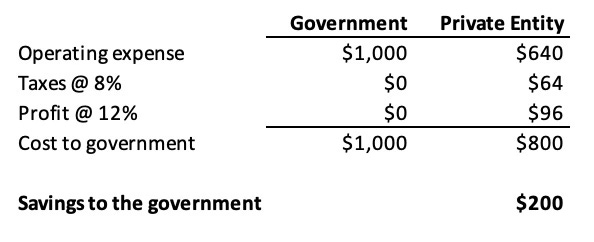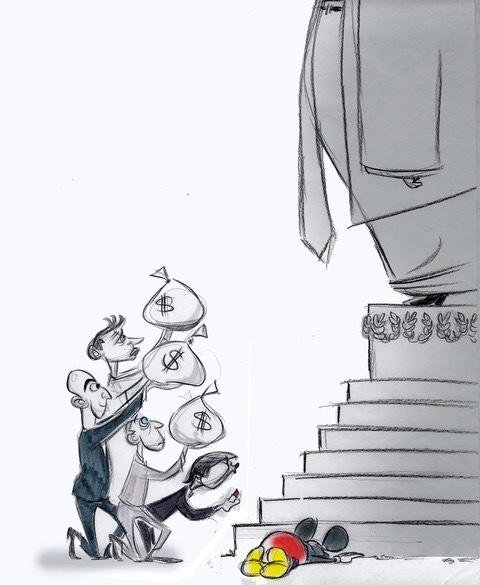Friends,
This is a digression from the exploration of the Constitution. Next time I’ll get back to the Constitution with a look at the Senate.
There’s a lot of chatter among Republicans about government efficiency and the virtues of privatization. Trump has put Musk in charge of the Department of Government Efficiency (DOGE). DOGE is not actually a department of the U.S. Government and it turns out there is already a department, the Government Accounting Office (GAO) which has made thousands of recommendations for improving government efficiency; most of which are ignored by Congress.
The Musk/Trump/DOGE narrative is that the Federal government has had huge growth and become very inefficient as compared with private industry. The solution is to get rid of a few hundred thousand government employees, move functions to the far more efficient private sector, and save the taxpayers $2T dollars per year.
Certainly we’ve all been frustrated with some government agency at one point or another and since they have no incentive to be efficient it seems plausible that their work could be done more efficiently in the private sector.
So let’s look at the growth in employment and the relative efficiency of the government versus private industry.
Lyrics to Private Dancer (made famous by Tina Turner)
Government employees and spending
We could spend months on the spending and categories, but for now I’d like to focus on just the subject of efficiency and employment. But feel free to give the spending numbers some thought and see a link to richer content below in What You Can Do.
Clearly the number of employees has risen much slower than the spending. Getting rid of a few hundred thousand employees will not save the $2T (now revised to $1T) per year that Musk aspires to cut. And surprisingly, Defense spending, while growing faster than inflation, actually declined as a percentage of GDP. However, at this point we don’t know the efficiency of any of this spending.
What would it take for private industry to be more efficient than the Government?
In many cases the government service is giving out money (e.g., Medicare), while in other cases there is a “product”, like a weather report, air traffic control, or regulation of food quality. The government starts off with several big advantages when it comes to efficiency:
It does not pay taxes
It does not need to make a profit
In 2023 the average net profit of the S&P 500 was about 12%. Different sources say the taxes actually paid by the S&P 500 in 2023 were in the range of 7% - 10%. Let’s make the numbers simple and call it 8%. The math gets a little tricky because those private industry percentages are of their revenue. If the government is going to save money, it must pay the private company less than the government spends, while delivering the same service or product.
Let’s say the privatization of a function should save the government least 20%. Otherwise, why bother? Here’s a simple example.
What the example says, is that in order to save the taxpayers 20%, the corporation with whom the government contracts must be able to deliver the service, or produce the product, for 36% less cost than the government. That’s a huge reduction in cost.
Many of the non-Defense spending programs involve giving out money. In order for a private entity to reduce the operating expense by 36%, without cutting benefits (i.e., the money provided to the recipients of the program), the administrative overhead of those agencies would need to be more than 36%. Is that likely? Let’s look at a real world example.
Medicare vs Private Health Insurance
Medicare is a government operated health insurance program that in 2023 covered approximately 65M people. Estimates of the administrative cost of Medicare range from 1.3% to 2.5%. Let’s call it 2%. In healthcare industry lingo, that means Medicare’s “medical care ratio” is about 98%
United Healthcare is the largest private health insurance company in the U.S. and in 2023 provided coverage to 49.5M people. United Healthcare reports that in 2023 its “medical care ratio” was 83.2%. This implies its operating expense, taxes and profits consume 16.8% of revenue which is a little less than the 20% in our example above.
Medicare and United Healthcare are roughly comparable in terms of the number of customers they serve. Both collect premiums and pay out benefits to doctors, hospitals and other healthcare providers. The government operated insurance program has an administrative cost of 2% versus the private company’s administrative cost of 17%. Clearly if United Healthcare was to administer Medicare, and provide the same benefits, it would increase the cost to the taxpayers. The increase would be at least 15% to cover United Healthcare’s taxes and earn a profit.
DOGE Dilemma
Suppose all other non-Defense spending is only half as efficient as Medicare, in other words they have an administrative cost of 4%. The total administrative expense of the other programs, which per above, after subtracting the cost of Medicare, was $4,478B in 2024, is only $180B. Making those programs as efficient as Medicare would yield only $90B in savings. I do not know the actual administrative cost of the other programs, but it doesn’t look like it could be anywhere near the 17% required to run United Healthcare, or the 36% that would be needed to actually reduce the cost to the taxpayers. And unless they are dramatically different than health insurance, privatization would likely increase the cost of delivering these services.
This leaves DOGE with the Department of Defense. The DOD spends money in all the states, but the top ten states account for 89% of DOD spending. Ranked in order of how much each state receives per resident they are:
Virgina: $18,400
Connecticut: $13,700
Maryland: $12,700
Alabama: $6,800
Massachusetts: $6,400
Arizona: $5,500
Washington: $5,400
California: $3,100
Texas: $3,000
Florida: $2,900
Cutting the DOD budget means reducing the income, jobs and tax revenues in these states. We’ll see how successful Trump/Musk are in cutting the DOD’s budget.
Efficiency
If we define “improving efficiency” as delivering the same results at a lower cost, rather than the same service or product, that opens up huge areas for debate. For example:
Is there a more efficient way for the U.S. to have the same level of defense against potential attacks?
Could we replace some ships and planes staffed by humans with drones controlled by a fraction the number of humans and without the facilities required to support humans in the plane or ship?
Could we replace some ground troops with robots?
Could we improve international relations and reduce the level of conflict in the world?
Would our country’s ability to feed itself be lost if we did not provide $18B per year in subsidies to the agriculture sector?
Would child care subsidies which enabled parents to work more be less expensive than food and housing subsidies?
Would replacing private health insurance with government health insurance provide better coverage at lower cost?
Should Medicare be allowed to negotiate for better prices of prescription drugs?
Should Medicare eligibility be adjusted for changes in life expectancy?
Do the benefits of “end of life” medical expenses justify the expense?
Would more accessible healthcare, and more preventive healthcare, improve productivity (i.e., people are at work instead of at the doctor)?
Is raising interest rates the best way to control inflation? Higher interest rates raise the interest cost of the national debt and put millions of people out of work, reducing the taxes they pay and increasing government expense for unemployment benefits.
Could we lower our national cost of energy by spending $20B / year on renewable energy projects, or improving the efficiency of the power grid (DC vs AC transmission lines), rather than subsidizing the fossil fuel industry?
The list goes on and on. These are enormous policy and technical debates. The debates need to be based on facts and are much more difficult than just slashing benefits and firing employees. They are the kinds of debates our legislatures should be having.
Summary
It’s very hard, if not impossible, for the government to privatize a program, deliver the same services and products, and save the taxpayers money.
The push for privatization is not about government efficiency and saving the taxpayers money, it’s about generating profits for the corporations to whom the government would outsource the service.
The reality is that the only way DOGE can reduce non-Defense spending by $1T is to reduce benefits. Those are policy decisions, not improvements in efficiency.
We have government to do together what we cannot do alone. The U.S. did not become the largest economy in the world with the highest productivity of any major economy because we’re doing it all wrong. But there is definitely room for improvement and a more nuanced and honest approach to government efficiency.
What You Can Do
The Washington Post declined to endorse a candidate in the last election. This was arguably to establish that it is a neutral source of fact based news without a political bias; or so we were told. Two weeks ago, the opinion editor vetoed this cartoon by Pulitzer Prize winning cartoonist Ann Telnaes, which showed Post owner Jeff Bezos, with other corporate CEOs, bowing down to Trump and pledging money to his inauguration. She resigned.
Last week, opinion columnist Jennifer Rubin resigned, and with a long list of other writers, founded The Contrarian. This article describes the extensive list of writers who will be contributing to The Contrarian. One of their contributors, Barbara McQuade, a former U.S. Attorney, is quoted below. I suggest you review what they are doing at The Contrarian and consider subscribing.
If you’re interested in digging a little deeper into the budget, one reader recommends USA Facts. USA Facts provides insights strictly by quoting numbers published by the government. There is little or no editorial opinion or spin. Click here for the segment on the budget.
You may remember Indivisible from the first Trump administration. They never went away. They have produced the attached Practical Guide To Democracy On The Brink - Strategies, Tactics, & Tips For How Everyday Americans Can Fight Back Together Wherever We Live.
And Remember…
One of the goals of disinformers is to cause people to become skeptical of everything, leading them to become exhausted and cynical until they disengage from politics altogether, right where an authoritarian wants them. - Barbara McQuade
The greatest weapon against stress is our ability to choose one thought over another. ⁃ William James









These are great, thanks.